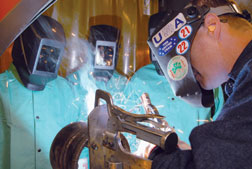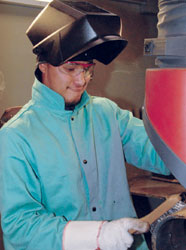With shortages of skilled workers in pipe trades among the highest anticipated for construction crafts, at least one supplier is reaching into new territory for recruits—Native American reservations.
 Pipe trades will be in high demand in future years. (Photo by Dean Battaglia/United Association Of Plumbers & Pipefitters)
|
This month, the plumbers’ and pipefitters’ union and the U.S. Interior Dept.’s Bureau of Indian Affairs launched a new program to fast-track apprenticeship for Native Americans in welding and pipefitting trades. About 20 trainees, from tribes in eight states, began instruction at a Mokena, Ill., training facility run by Local 597, the union’s Chicago-area local that also is its largest. But with response great, future programs are anticipated elsewhere.
“This will be an ongoing program,” says Michael Arndt, national training director of the United Association of Journeymen and Apprentices of the Plumbing, Pipefitting and Sprinkler Fitting Industry of the U.S. and Canada, based in Washington DC. (UA). “The applicants seem to be very good.”
In fact, the union received more than 90 applications in just one day for its Hybrid Welding program that runs for 16 weeks, with students training eight hours per day. Upon completion, they will be rated as two-year apprentices, at a minimum, and possibly higher depending on skills, says Arndt. Journeymen pipe fitters typically earn $30 to $40 an hour in wages, depending on location and other factors. The UA has scheduled another 16-week training session at a Phoenix facility run by Local 469 at month’s end and is planning two others later this fall.
 Native Americans are enthusiastic. (Photo by Dean Battaglia/United Association Of Plumbers & Pipefitters)
|
When training is completed, apprentices will be assigned to locals where work is available. “Most trainees are enthusiastic about relocating,” says Arndt. “There usually is not a lot of work where they live.” The first trainees come from the Blackfeet, Winnebago, Leech Lake, Spokane and Menominee tribes, among others. “This program gives them a much higher wage and a career path, and we need these skilled workers,” say Arndt.
According to the Bureau of Labor Statistics, 450,000 welders will be needed nationwide by 2014. UA General President William Hite says the union is committing more than $140 million to all training this year, hoping to train 50,000 apprentices. Arndt expects a typical 10% dropout rate in the new UA program, modeled after one the union sponsors for military veterans, who can begin training on base while awaiting discharge.
“We are extremely excited about this,” says Lynn Forcia, chief of the workforce development division in the office of the Interior Dept.’s assistant secretary for Indian affairs. “It’s our most important initiative right now.” She says that under a memorandum of understanding with the UA, the union provides training at no cost, as well as work clothing, tools and equipment. The department covers trainees’ housing, food and transportation costs. Applicants must have a GED or be a high school graduate, and all undergo a drug test. Forcia says the program operates under Public Law 102477, which authorizes the bureau to combine training under one resource to coordinate outreach to 562 native American tribes.
“A lot of Native Americans living on or near the reservation are either unemployed or making minimum wage,” says Forcia. The program offers potential to “earn salaries that are a real livable wage. We have no problem finding potential recruits. My phone has been ringing off the hook.”

Post a comment to this article
Report Abusive Comment